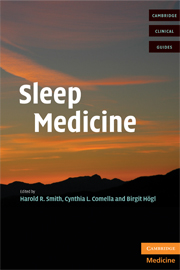2 - Evaluation and testing of the sleepy patient
from SECTION 1 - NORMAL SLEEP
Published online by Cambridge University Press: 08 August 2009
Summary
Introduction
Sleep disturbances can affect people throughout their life span, and the frequency of sleep disturbances increases as we age. Currently, there are more than 80 sleep disorders that are described in the second edition of the International Classification of Sleep Disorders (ICSD-2). There is mounting evidence showing that sleep disorders are closely related to comorbid medical and neurological diseases. Sleep deprivation has been shown to be a possible risk factor for obesity. Untreated obstructive sleep apnea (OSA) is associated with an increased risk of having elevated blood pressure and insulin resistance. Untreated OSA may also be associated with an increased risk of heart attack or stroke. Specific epilepsies occur exclusively during sleep, and sleep deprivation may provoke seizures. Individuals with REM sleep behavior disorder (RBD) are at a higher risk for developing a neurodegenerative disorder such as Parkinson's disease or dementia.
It is the responsibility of healthcare providers to inquire about sleep quality and any possible sleep disruptions in their patients. People with sleep disturbances may complain of difficulty falling asleep or maintaining sleep, abnormal behaviors during the night, daytime sleepiness or fatigue. Multiple sleep disorders can be present in one individual, causing a decreased quality of life. A systematic approach is therefore crucial in facilitating the evaluation, diagnosis, and treatment of sleep disorders.
When evaluating someone for sleep disorders, a comprehensive and detailed sleep history is often the most important part of the evaluation.
Keywords
- Type
- Chapter
- Information
- Sleep Medicine , pp. 25 - 46Publisher: Cambridge University PressPrint publication year: 2008
References
- 1
- Cited by

